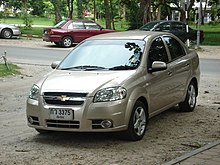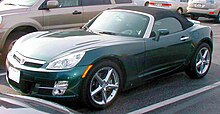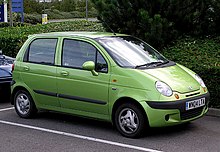GM Korea: Difference between revisions
No edit summary |
m external link |
||
| Line 186: | Line 186: | ||
;Korea |
;Korea |
||
* [http://www.gmdaewoo.co.kr/ GM Daewoo Homepage] |
* [http://www.gmdaewoo.co.kr/ GM Daewoo Homepage] |
||
* [http://wiki.gmnext.com/wiki/index.php/GM_Daewoo Official ''Generations of GM Wiki'' site: GM Daewoo] |
|||
* [http://www.gmdaewoo.co.kr/eng01/news/news02_list.jsp GM Daewoo English News Corner] |
* [http://www.gmdaewoo.co.kr/eng01/news/news02_list.jsp GM Daewoo English News Corner] |
||
* [http://buy.dm.co.kr/ GM Daewoo Shopping Mall Homepage] |
* [http://buy.dm.co.kr/ GM Daewoo Shopping Mall Homepage] |
||
Revision as of 17:08, 26 May 2009
This article needs to be updated. (April 2009) |
| File:GM Daewoo logo.png | |
| Company type | Subsidiary of GM |
|---|---|
| Industry | Automotive |
| Founded | 1937 |
| Founder | Kim Woo-jung |
| Headquarters | , |
Key people | President and CEO: Michael A. Grimaldi |
| Products | Automobiles Consumer goods |
| Parent | General Motors (50%) |
| Website | gmdaewoo.co.kr |
GM Daewoo Auto & Technology (GM Daewoo or GMDAT) was first established as National Motor in 1937 in Bupyeong-gu, Incheon, South Korea. After changing its name to Saenara Motor in 1962, Saenara Motor was bought by Shinjin Industrial in 1965, which changed its name to Shinjin Motor after establishing collaborations with Toyota.
After Toyota's withdrawal in 1972, Shinjin Motor started a joint venture with General Motors under the name General Motors Korea, but was renamed again in 1976 to Saehan Motor. After the Daewoo Group gained control in 1982 the name was changed to Daewoo Motor. In the early 1990s the company started to expand heavily throughout the world. Until 1996 all cars were based on models from General Motors. After the Asian financial crisis started in 1997, it took over the troubled 4WD specialist SsangYong in 1998, but ran into financial trouble in 1999.
In 2001 General Motors decided to buy most of Daewoo Motor's assets to form GM Daewoo. The new company started operations on October 17, 2002, with GM and its partners Suzuki and SAIC holding a stake of 66.7% with investments of US$400 million. The GM holding was formally purchased by GM Holden Ltd which holds a seat on the board [1]. The remaining equity stake of 33.3% was held by Korea Development Bank and several other Korean creditors with investments of US$197 million. The deal did not include 15 plants, especially Daewoo's oldest plant in Bupyeong-gu which now operates under the name Daewoo Incheon Motor Company as a supplier to GM Daewoo; General Motors plans to buy this plant by 2008.[citation needed] In 2004, Tata Motors purchased Daewoo's Truck manufacturing unit. In February 2005, GM invested US$49 million to raise its share in the company to 48.2%. Furthermore, GM acquired 6.9 million shares in GM Daewoo for US$21 million from Suzuki Motors in August of the same year. General Motors' share in GM Daewoo then increased to 50.9%. Suzuki still holds 11% of GMDAT but is reported to be considering selling this to GM.
GMDAT has design, engineering, research & development facilities that are involved in development for various GM products. On November 25, 2003, the design center was relocated to the new 2-story building at the Bupyeong-gu headquarters and assigned the task to style a new SUV based on GM's Theta automobile platform to be released in 2006.
GMDAT has manufacturing plants in Korea and an assembly plant in Vietnam. GMDAT-designed cars are also assembled in mainland China, Thailand, India, and Colombia (as of February 2005). Its cars are marketed in over 140 countries (as of February 2005). In 2004, GMDAT sold more than 900,000 vehicles worldwide.
Car models
Daewoos were first sold around the world as the Daewoo LeMans or Pontiac LeMans or known as Daewoo Racer, a model based on the Opel Kadett E. The Saehan Bird, based on the General Motors T-car platform, was exported to Malaysia as the Opel Gemini; this was also known in South Korea as the Daewoo Maepsy. A larger Opel Commodore-based model, called the Daewoo Royale was also available. The Daewoo Prince, which had commonalities with the Australian Holden Commodore, was built until 1993.
In the 1990s, Daewoo expanded its presence under its own brand, notably in Europe, where it sold the Opel Ascona-based Espero and Kadett-based Daewoo Nexia (also Racer and Cielo in the domestic market; the latter is often spelled as Ciero for more Korean-like sound. The Cielo was named Heaven (Cielo means heaven in Spanish) in the Chilean market.
Ssangyong models Korando and Musso were sold briefly under the Daewoo brand in certain European countries (most notably France and Germany) from 1999 to 2001.

Under the supervision of Dr. Ulrich Bez, Daewoo developed its own models not based on any GM platform. These were codenamed as the T100, J100 and V100, reflecting the code names used by General Motors, with Italdesign Giugiaro working on the T100 and V100. The J100 was designed by IDEA of Italy. These were exported from late 1998 to Daewoo Motor America as the sub-compact Daewoo Lanos, compact Daewoo Nubira ("to go everywhere/anywhere" in Korean), and the mid-size Daewoo Leganza (similar to "eleganza" in Italian). Other markets received these three cars, too. The Leganza's styling was reportedly based on an Italdesign show car based on Jaguar XJ-12 mechanicals; the real thing was more modest, with Holden-built 2.2 L engines shipped from Melbourne to Daewoo's Korean plant.
The Rezzo/Tacuma minivan and the Matiz/Spark micro-car are other models sold by Daewoo in various markets. The Magnus/Evanda is a development of the Leganza. The Daewoo Kalos subcompact was released in late 2002. A new version of the Nubira sedan was released in 2003 while the Daewoo Lacetti, a 5-door hatchback version of the Nubira, followed in 2004. The Kalos and the Lacetti were styled by Giugiaro, and styling of the Nubira sedan was the responsibility of Pininfarina. These models are sold under the Chevrolet brand in Europe.
Overseas engagements
Daewoo owned a share of ZAZ, an automobile manufacturer based in Ukraine, from 1998 to 2003. The CKD assembly of the Daewoo Lanos started 2002 and lately it was adopted for full-scale production as the ZAZ Lanos. A version of the Daewoo-developed Chevrolet Aveo is being assembled for local market at the Iliychevsk subsidiary.

In August 1992, Daewoo set up UzDaewooAuto, a joint venture and a factory in Asaka city, Andizhan province, Uzbekistan, leveraging the presence of a large local ethnic Korean minority. Currently, the plant assembles the Matiz and the Nexia for both the local market and export, as well as the Lacetti hatchback and sedan for the domestic market only.
Daewoo also invested into Poland's Fabryka Samochodów Osobowych in 1995, forming a joint venture for assembly of the Matiz microcar, a successor to the Tico that was very popular in the Eastern European market. Since January 2005 FSO began to produce Matiz and Lanos under their own trademark.
Since 1995, Daewoo has acquired a factory in Craiova, Romania which was producing a derivate of a Citroën model, the Oltcit. The entire production facility was refurbished to mainly produce the Cielo model and later, other models. Until 2008 it was producing the Daewoo Cielo, Matiz and Nubira models for the Romanian market, but also car parts for export, such as engines and gearboxes to GM Daewoo and to other companies. The factory was acquired by the Romanian Government and sold to Ford in 2007 (the official agreement was signed on 21 March 2008). The production of Daewoo models was stopped in May, 2008, and the name "Daewoo Automobile Romania" was changed to "Ford Romania".
In 1998, the low-volume assembly of the Lanos, Nubira and the Leganza started in Taganrog, Russia, at the TagAZ factory. The cars were sold on the local market under the Doninvest brand, as the Assol, the Orion and the Kondor, respectively. The project did not have much success, so TagAZ recently turned to Hyundai and started producing the Hyundai Accent and the Kia Rio
Following the GM buyout in 2002, GM Daewoo lost interest in its overseas assets; the deals on supplies of pre-assembled CKD kits will end in 2005 and the facilities are likely to rely on its own production capabilities from that point on.
Badge engineering
GM changed the Daewoo name to something with more prestige in order to increase sales in the local market. GM decided to comply and started selling the Daewoo Lacetti as Chevrolet Optra. This was the first time GM sold re-badged Daewoo cars.
No Daewoo-built vehicles were offered in the US for the 2003 model year. However, Daewoo exports found their way to countries such as Canada, India and the People's Republic of China. In some places of the world (notably Canada, India and Israel) the Daewoo brand did not exist at the time anymore and Daewoo cars were sold as "Chevrolet."

The re-branded Daewoo models sold in Israel succeeded far beyond GM's expectations so the Daewoo re-branding strategy was adopted to other countries as well. In most European countries however, GM retained the Daewoo brand and original model names until December 31, 2004.
GM Daewoo-built vehicles returned to the US market in 2004 and continue to be marketed to this day. The Chevrolet Aveo, Suzuki Forenza and Suzuki Reno, all offered in the US market, are re-badged Daewoos (they are sold in South Korea as the Daewoo Gentra, Lacetti sedan, and Lacetti hatchback, respectively).
In 2005, GM branded most Daewoos as Chevrolets in most markets, with Europe starting in January. Exceptions are China (where the cars are rebadged as Buick and Chevrolet), South Korea (GM Daewoo), Vietnam (where Daewoo is retained), Australia and New Zealand (Holden), the United States (Chevrolet, Suzuki), and Canada (Chevrolet, Pontiac, and Suzuki). The intent of utilizing the Chevrolet brand worldwide is to make Chevrolet a global brand of GM. One casualty of this is that the "Nubira" name disappeared in favor of "Lacetti" in the UK, although the "Nubira" sedan remains in the rest of the Europe.
In areas where GM Daewoo has no official distributors, it is possible to buy the same car under several brand names.
Recent developments

The Daewoo Kalos, which was exported globally as the Chevrolet Aveo, was released in September 2005. The Daewoo Tosca, the Magnus replacement, appeared in early 2006.
The Daewoo Winstorm SUV, based on the Chevrolet S3X concept developed using the GM Theta platform, was released in summer 2006. Two different variants are sold worldwide, including: in South Korea as Daewoo Winstorm, in Europe as the Chevrolet Captiva and Opel/Vauxhall Antara, the USA as the Saturn Vue, and Australia as the Holden Captiva and Captiva Maxx. It features a common rail Diesel engine for the first time in a Daewoo vehicle, in addition to regular four and six cylinder gasoline engines. The diesel engine design is licensed from the Italian engine maker VM Motori.
Developed by a global design and engineering team, Daewoo Lacetti Premier was introduced in October, 2008.
Future plans
GM Daewoo will also take responsibility for developing the future version of the GM Gamma platform, currently used by the Opel Corsa D and the Fiat Grande Punto. Therefore, it has been speculated that the Chevrolet Corsa C, sold in Latin America since 2002, may be replaced or joined by a slightly modified version of the Corsa D - in the latter case, it might be named Astra (like the Chevrolet Vectra, which is a Opel Astra C with a different front end), and the Corsa may be followed by a Kalos/Aveo built on the Corsa B's platform with many shared pieces with the Chevrolet Celta.
Manufacturing facilities
- Bupyeong-gu: vehicle assembly and gasoline/LPG engine manufacturing (production capacity: est. 440,000/year)
- Gunsan: vehicle assembly and diesel engine manufacturing (production capacity: est. 260,000/year)
- Changwon: vehicle assembly and gasoline/LPG engine manufacturing (production capacity: est. 210,000/year)
- Boryeong: transmission and engine components manufacturing
- VIDAMCO at Hanoi: vehicle assembly (production capacity: est. 11,000/year)
List of Daewoo models
Passenger cars
- Daewoo-based models
- Espero (1990–1997, also known as the Aranos)

A Daewoo Kalos in Thailand - Kalos (2002–present, also marketed as the Chevrolet Aveo/Kalos, Daewoo Gentra/Gentra X Holden Barina, Pontiac Wave, and the Suzuki Swift+)
- Lacetti (2003–present, also known as the Suzuki Forenza, Chevrolet Optra/Lacetti, Holden Viva and Buick Excelle/Excelle HRV)
- Lanos (1996–present, also known as the Doninvest Assol, ZAZ Lanos (Sens), FSO Lanos and Chevrolet Lanos)
- Leganza (1997–2002, also known as the Doninvest Kondor)
- Magnus (2000–2006, also known as the Evanda, Chevrolet Epica/Evanda, Suzuki Verona, Formosa Magnus)
- Matiz (1998–present, also known as the Chevrolet Matiz/Spark/Joy, Formosa Matiz, FSO Matiz and Pontiac Matiz G2)
- Nubira (1997–2003), also known as the Doninvest Orion)
- Tacuma (2000–present, also named as the Chevrolet Tacuma/Rezzo/Vivant)
- Tosca (2006–present, also known as the Chevrolet Epica or Holden Epica)
- Winstorm (2006–present, also known as the Chevrolet Captiva and Holden Captiva)
- Winstorm MaXX (2008-present, also known as Opel Antara and Vauxhall Antara and Holden Captiva MaXX)
- Espero (1990–1997, also known as the Aranos)
- Holden-based models
- Veritas (2008–present, rebadged Holden Caprice, also known as the Chevrolet Caprice and Buick Park Avenue)
- Statesman (2005–2006, rebadged Holden Statesman)
- Honda-based models
- Arcadia (1994–2000, rebadged Honda Legend)
- Opel-based models
- Cielo (1994–1997, based on the Opel Kadett E, also known as the Cielo, Heaven, Nexia, Racer.)
- LeMans (1986–1994, based on the Opel Kadett E, variants were the Racer (sedan) and Penta (hatchback), also known as the 1.5i (Australia), Fantasy (Thailand), Pointer, Asüna GT (Canada 1991–1993 hatchback), Asüna SE (Canada 1991–1993 sedan), Passport Optima (Canada 1989–1991) and Pontiac LeMans (North America).)
- Maepsy (1982–1986, based on the Opel Kadett C)
- Prince (1991–1997), based on Opel Rekord E, also known as the Super Salon and Brougham (1991–1999)
- Royale (1975–1991, first generation (1975–1978) based on Opel Rekord D, second generation (1980–1991) based on Opel Rekord E, variants: Royale Salon/Royale XG/Royale Prince/Royale Duke/Royale Diesel.)
- Saturn-based models
- G2X (2007–present, rebadged Saturn Sky Red Line)

The Daewoo G2X, or Saturn Sky
- G2X (2007–present, rebadged Saturn Sky Red Line)
- SsangYong Motor Company-based models
- Chairman (Rebadged SsangYong Chairman)
- Istana (Rebadged SsangYong Istana)
- Korando (1999–2001, rebadged SsangYong Korando)
- Musso (Rebadged SsangYong Musso)
- Suzuki-based models
- Damas (1991–present, rebadged Suzuki Carry)
- Tico (1991–2001, rebadged Suzuki Alto)
Commercial vehicles
- Daewoo's commercial vehicle business was acquired by Tata Motors in 2004. The business is now known as Tata Daewoo Commercial Vehicle. Daewoo Bus is not owned by Tata.
- Daewoo BM090

A Daewoo BH120 bus in Taiwan (ROC) - Daewoo BS090
- Daewoo BF101/105
- Daewoo BS105/106
- Daewoo BV101
- Daewoo BV113
- Daewoo BH113
- Daewoo BH115
- Daewoo BH115E
- Daewoo BH116
- Daewoo BH117
- Daewoo BH120(H)
- Daewoo Chasedae Truck
- Elf (Rebadged Isuzu Elf)
- Daewoo Lublin
Concept cars
- Daewoo DEV-4 (1994) - electric vehicle based on the Daewoo Cielo

2004 GM Daewoo M3X - Daewoo No.1 (1995)
- Daewoo No.2 (1995)
- Daewoo Mya (1996)
- Daewoo Tacuma (1997)
- Daewoo Joyster (1997)
- Daewoo Matiz (1997)
- Daewoo DEV-5 (1997)
- Nubira HEV / Leganza NGV (1997)
- Daewoo Shiraz (1997)- all 1997 concepts shown in the 1997 Seoul Motor Show
- Daewoo Mirae (1999)
- Daewoo DMS-1 (1999)
- Daewoo Musiro (2000)
- Daewoo Vada (2001)
- GM Daewoo Flex/Universe (2001)
- GM Daewoo Oto/Scope (2003)
- GM Daewoo M3X (2004) - third generation of Matiz since 2005
- GM Daewoo S3X (2004) - GM Daewoo Winstorm since 2006
- GM Daewoo T2X (2005)
- Chevrolet WTTC Ultra (2006) - designed by the GM DAT Design Center
- GM Daewoo G2X (2006) - sold in South Korea since the end of 2007
- Chevrolet Trax (2007) - designed by the GM DAT Design Center
- Chevrolet Beat (2007) - designed by the GM DAT Design Center
- Chevrolet Groove (2007) - designed by the GM DAT Design Center
See also
- List of Korea-related topics
- List of Korean car makers
- Tata Daewoo Commercial Vehicle (not affiliated with GM Daewoo)
- Daewoo Bus (not affiliated with GM Daewoo)
- Daewoo Motor Sales
- UzDaewooAuto (not affiliated with GM Daewoo)
References
External links
- Korea
- GM Daewoo Homepage
- Official Generations of GM Wiki site: GM Daewoo
- GM Daewoo English News Corner
- GM Daewoo Shopping Mall Homepage
- GM Autoworld Korea Homepage
- Worldwide
- Daewoo Motor Vietnam
- Daewoo Motor Romania (not affiliated with GM Daewoo)






